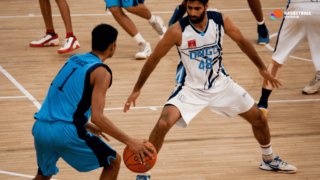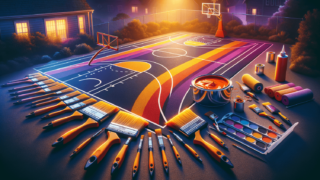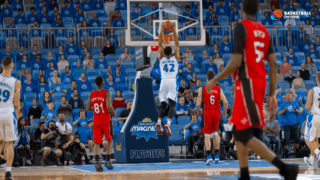
As b-ball aficionados glide their way to victory, a crucial aspect of their gear often goes unnoticed – their footwear. Are basketball shoes truly slip-resistant? Buckle up, dear reader, as we bounce, slide, and pivot through the fascinating world of basketball shoe technology. We’re about to break down the importance of grip, explore the vast spectrum of traction patterns, and unravel the hidden secrets behind the sneakers that make a slam dunk look so effortless. Lace up and join us for an exhilarating deep-dive that will have you gripping the edge of your seat – both figuratively and literally!
Are Basketball Shoes Slip Resistant?
Yes, basketball shoes are designed to be slip-resistant. They generally have an effective traction and grip pattern on the outsole, specially engineered to enhance grip on the court, so players can quickly change direction, accelerate, and decelerate with limited skidding. The level of slip resistance may vary among models and brands, but overall, these shoes aim to provide a stable and secure foundation for optimum on-court performance.
Traction: The Key to a Slip-Resistant Shoe
A basketball shoe’s ability to prevent slipping hinges on the traction it provides. Quality traction not only promises a firm grip on the court but also endows players with the flexibility to make swift maneuvers without losing their footing. To truly understand how basketball shoes prevent slipping, we must first delve into the vibrant world of traction technology.
The Science of Grip: Outsole Rubber Composition
The rubber composition featured in the outsole of a basketball shoe is a vital factor determining its slip-resistance capabilities. Different rubber compounds affect traction, grip, and overall shoe durability. Let’s probe deeper into two rubber types commonly used in basketball shoes and their impact on slip-resistance:
Natural Rubber
Natural rubber has established itself as a prominent choice for indoor basketball shoes due to its extraordinary grip on pristine hardwood courts. It possesses high adherence, allowing players to pivot, change direction, and halt with ease. However, it wears down relatively quickly, making it less suitable for outdoor basketball enthusiasts.
Carbon Rubber
Carbon rubber, a blend of natural rubber and carbon, is a potent alternative for those seeking a longer-lasting, outdoor-friendly option. This robust concoction ensures both excellent durability and ample grip, albeit slightly subpar compared to its natural counterpart. Consequently, carbon rubber-based outsoles are favored for their versatility across different court surfaces.
Gripping Patterns: Variety in Traction Styles
Outsole design is integral to the performance of basketball shoes. An array of traction patterns cater to different play styles, weight distributions, and personal preferences. We’re about to examine some popular traction styles found in basketball shoes:
Herringbone
An iconic pattern that has stood the test of time, the herringbone design boasts a series of zigzag lines reminiscent of a fish skeleton. Owing to its multidirectional grip and reliable stopping power, this pattern is widely adopted by renowned basketball shoe brands. Furthermore, since it’s less susceptible to dirt accumulation, maintaining a herringbone outsole is a breeze.
Story-Telling Patterns
Story-telling traction patterns often feature player-inspired motifs, numerals, or intricate designs that transcend mere aesthetics to provide essential grip on the court. Magnetic as the designs may be, their functionality often varies. Although certain story-telling patterns can prove as effective as the herringbone, others might fall short in providing consistent traction. Thus, it’s crucial to research the pattern’s performance before committing to these shoes.
Circular or Spiral
The circular or spiral traction pattern comprises circles or curved lines connected in a concentric, swirling motion. This design promotes unrestricted multidirectional movements, rendering it ideal for players fond of pivoting and making unpredictable directional changes. However, some spiral patterns might struggle to maintain grip on dust-ridden courts.
Adapting to Climate: Slip-Resistance for Indoor and Outdoor Courts
Climate and court types considerably influence the quality of traction in your basketball shoes. Slip-resistant shoes must account for these variations to provide a grip that’s unrivaled regardless of the environment. Here’s how basketball shoes adapt to indoor and outdoor courts:
Indoor Court Adaptation
Indoor courts typically feature hardwood, polished surfaces that necessitate a tender yet robust grip. Therefore, shoes designed for indoor use sport natural rubber outsoles and softer patterns to maximize traction while ensuring an optimal balance between flexibility and stability.
Outdoor Court Adaptation
Outdoor courts exhibit expanded traction requirements due to varying surfaces, such as concrete and asphalt. Outdoor basketball shoes must be hard-wearing and boast carbon rubber outsoles, enabling players to tackle the rough terrain with confidence. To further enhance grip, they often incorporate coarser tread patterns that minimize the risk of slippage on uneven surfaces.
Outsole Maintenance: Preserve Traction and Prolong the Fight Against Slippage
Maintaining your basketball shoes is essential for retaining excellent slip-resistance over time. Employment of certain techniques can minimize wear, ensuring the longevity of your basketball shoes and preserving their slip-resistant nature:
Proper Court Etiquette
Avoid wearing your indoor basketball shoes outside, as the rough terrain can deteriorate traction far more rapidly than indoor courts. By sticking to court etiquette and donning appropriate footwear, you not only protect your shoes but also preserve the court surface for your fellow basketball players.
Regular Cleaning
Accumulated dust, dirt, and debris can substantially hinder your grip on the court. Regularly clean your shoes’ outsoles to boost traction and minimize slippage. Wipe down the outsoles with a clean, damp cloth and allow them to dry properly before sporting them again. For a more intensive clean, utilize a soft brush and mild soap to eliminate stubborn dirt.
Ensuring Ideal Court Conditions
Ensure that the indoor court is well-maintained and regularly cleaned. A pristine hardwood surface complements the slip-resistant nature of your basketball shoes, granting you maximum grip on the court. Encourage your teammates and fellow players to promote a clean court culture – teamwork makes the dream work!
Slip-Resistance Depends on the Player: The Importance of Personalized Fit
In the quest for optimal slip-resistance, it’s crucial to recognize that every player is unique. Acknowledging the importance of customized fit and personal preferences can significantly impact how well your basketball shoes grip the court. Let’s explore some factors that contribute to superior personalized slip prevention:
Finding the Perfect Fit
A secure, snug fit is indispensable for preventing heel slippage and unlocking the full potential of your basketball shoes. To determine the perfect fit, pay keen attention to width, cushioning, and lock-down features like lacing systems and ankle straps, all of which can make or break the slip-resistant prowess of your footwear.
Identifying Your Play Style
Recognize your play style to select basketball shoes equipped with the most compatible traction pattern. While some players prioritize sharp cuts and rapid changes of direction, others might focus on explosive sprints or rapid stops. As such, identifying the outsole design that aligns with your play style is key to guaranteeing unrivaled slip-resistance on the court.
Considering Arch Support and Weight Distribution
It’s vital to appreciate the nuances of your arch and weight distribution to ensure your basketball shoes deliver maximal grip. A well-supported arch allows for balanced weight distribution, which in turn facilitates stable movements and impressive traction. Thus, finding shoes that cater to individual arch needs means gaining a personalized ally against slippage.
From the beguiling patterns adorning its outsoles to its intricate concoction of rubber compounds, a basketball shoe conceals numerous surprises. Armed with this newfound knowledge, you can now effortlessly enhance your slip-resistance on the court and glide your way to basketball glory.
Choosing the Right Shoe: Brands and Models that Shine in Slip Resistance
With an ever-growing assortment of basketball shoes on the market, selecting the perfect slip-resistant pair can seem overwhelming. Let’s take a closer look at some popular brands and their esteemed models that consistently deliver exceptional slip-resistance:
Adidas
Adidas, a brand with an illustrious history in sportswear, has some remarkable basketball shoe models under its belt. The Adidas Harden, D-Rose, and Crazy Explosive are just a few examples that boast superior slip-resistant outsoles, suitable for players searching for a firm grip on the court and a comfortable fit.
Nike
As a pioneering brand in the basketball shoe industry, Nike offers stellar options for players seeking slip-resistant footwear. Renowned models like the Nike Kyrie series, Kobe series, and the LeBron lineup—all designed and endorsed by NBA icons—provide exceptional slip-resistance, durability, and support for avid basketball players.
Under Armour
Under Armour is another major player in the basketball shoe arena. The brand has made strides in producing slip-resistant, performance-enhancing shoes, such as the popular Under Armour Curry series. Designed in collaboration with NBA superstar Stephen Curry, these shoes deliver exemplary slip-resistance, pleasing athletes worldwide.
Reebok
Though Reebok’s dominance in the basketball shoe industry has eased over time, it remains a brand with quality offerings. Reebok’s Shaq Attaq line, endorsed by NBA Hall-of-Famer Shaquille O’Neal, captures attention for its commendable slip-resistance without sacrificing support and style.
The Role of Budget in Selecting Slip-Resistant Basketball Shoes
When scouring the market for the ideal slip-resistant basketball shoes, a crucial consideration is the price tag. Numerous factors can impact the cost of basketball shoes, such as brand popularity, celebrity endorsements, materials, and technology. While it’s essential to consider these aspects, it’s also possible to find reliable, slip-resistant basketball shoes at a reasonable price.
Comparing Price Points
Slip-resistant basketball shoes can vary widely in price range, from below $70 for budget models to $200 or more for premium counterparts. A higher price tag can reflect enhanced materials, technology, and design, but it doesn’t automatically guarantee superior slip-resistance. Likewise, more affordable options may still deliver satisfying slip-resistant performance, albeit with potential sacrifices in other areas such as comfort or durability.
Shopping Smart: Tips for a Budget-Friendly Purchase
To get your hands on excellent slip-resistant basketball shoes without breaking the bank, consider adopting these savvy shopping strategies:
- Prioritize reputable brands known for quality slip-resistance at competitive pricing, such as Adidas or Under Armour.
- Look out for sales, discounts, and previous seasons’ models to secure high-quality basketball shoes at reduced prices.
- Research and read customer reviews to gauge the slip-resistant performance of affordable shoes before purchasing them.
- In-store fittings will help ensure a comfortable shoe match while also allowing you to test out the slip-resistance on a trial court.
In summary, balancing your desire for slip-resistant basketball shoes with your budget can be achieved through intelligent decision-making and a discerning eye. Owning the perfect pair of slip-resistant basketball shoes is not only fulfilling but also paves the way toward peak court performance.
Frequently Asked Questions (FAQ)
Interested in acquiring additional knowledge about slip-resistant basketball shoes? Dive into our FAQ section, where we address some common queries related to this topic. From shoe care tips to brand-specific concerns, these questions and answers aim to further expand your understanding of slip-resistant basketball shoes:
1. How often should I replace my basketball shoes to maintain slip-resistance?
The frequency of replacing your basketball shoes depends on factors such as playing frequency, court surface, shoes’ built and material quality, and personal preferences. Generally, indoor basketball shoes should be replaced every 6-12 months, while outdoor shoes may require replacement as early as 3-6 months.
2. Can I improve the shoe grip with aftermarket accessories?
Yes, there are aftermarket grip-enhancing products like grip-enhancing sprays and traction pads that you can use to improve your shoe grip. However, they might not match the performance of a quality basketball shoe’s built-in slip-resistance features.
3. Do certain colorways affect the slip-resistance of basketball shoes?
No, the colorway of a basketball shoe does not impact its slip-resistance. Though color choices may be tied to limited edition releases or special materials, the shoe’s grip and traction will generally remain similar across various colorways of the same model.
4. How can I tell if my basketball shoes are losing their grip?
Signs of diminishing grip may include noticeable slipping on the court, difficulty changing direction rapidly, and an increase in the frequency of wiping the outsoles. Visible wear on the traction pattern or outsole may also suggest that it’s time to replace your shoes.
5. Can I use a hairdryer to remove dirt from my shoe outsoles?
Using a hairdryer to remove dirt from your shoe outsoles is not recommended, as heat exposure may alter the rubber compound or damage the shoe’s adhesive. Instead, use a soft brush or damp cloth to clean the outsoles for better maintenance and longevity.
6. Does new shoe grip improve over time as they “break in”?
Some basketball shoes may require a “break-in” period during which the grip may slightly improve. However, in most cases, the shoe’s initial grip is indicative of its performance. Prolonged use will likely decrease grip because the outsoles naturally wear down over time.
7. Can I use a tennis shoe grip enhancer for my basketball shoes?
Tennis shoe grip enhancers, such as grip-enhancing sprays and pads, can potentially improve the grip of basketball shoes. However, efficacy may differ due to distinct court surfaces and playing dynamics. It’s worth experimenting, but remember that a high-quality basketball shoe is designed to offer maximum slip-resistance.
8. What can I do if my basketball shoes aren’t providing enough slip-resistance?
If your basketball shoes lack satisfactory slip-resistance, consider cleaning the outsoles, trying a different model or brand, and investing in quality aftermarket grip-enhancing products. It’s essential to prioritize a shoe that matches your play style, court surface, and personal preferences.
9. Are low-top or high-top basketball shoes better for slip-resistance?
Slip-resistance is mostly determined by shoe outsoles and traction patterns rather than the high-top or low-top design. Both styles can offer excellent slip-resistance, but individual preferences regarding ankle support and mobility should guide your choice between high-top or low-top shoes.
10. Are there any specific basketball shoes designed for wide feet with great slip-resistance?
Many basketball shoes cater to players with wide feet while maintaining excellent slip-resistance. Popular options include New Balance’s Omn1s, Nike’s LeBron series, and Under Armour’s Curry series. Trying on shoes and testing their custom fit will help determine which model is best for you.
11. How can I maintain traction on very dusty courts?
To maintain traction on dusty courts, consider employing the following strategies: frequently wipe the outsoles during gameplay, regularly clean the shoes with a damp cloth or soft brush, and choose basketball shoe models known for their performance in dusty conditions, such as those with herringbone traction patterns.
12. Are there sustainable, eco-friendly slip-resistant basketball shoes available?
Yes, a growing number of sustainable, eco-friendly basketball shoes exist on the market, many of which provide great slip-resistance. Brands like Adidas, Nike, and Allbirds offer models made from recycled or environmentally-friendly materials without compromising performance, comfort, and grip.
13. Does wearing two pairs of socks improve slip-resistance?
Wearing two pairs of socks might improve in-shoe fit and minimize heel slippage, but it will not directly impact the slip-resistance offered by the shoe’s outsole. To ensure optimal slip-resistance, focus on the shoe’s traction pattern, outsole material, maintenance, and fit.
Featured Posts
- No pillar pages found.





